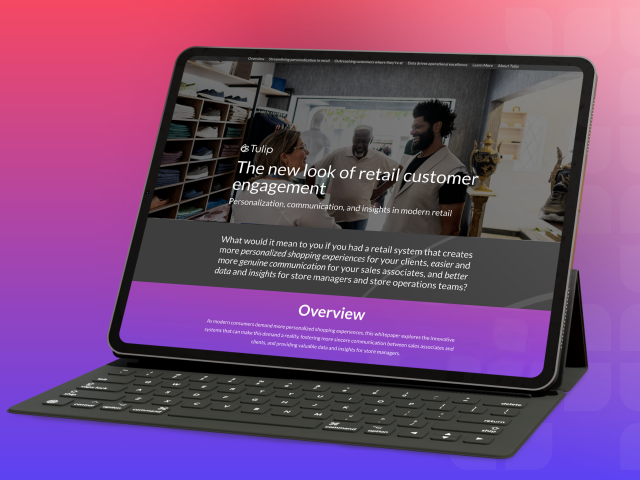Retail executives need to make strategic and operational changes to respond to customer needs and evolving best practices if they’re going to succeed in today’s tumultuous retail environment. Digital-first brands are able to pivot almost instantaneously, setting up new experiences, changing the customer journey, and offering new levels of personalization on an almost daily basis. By contrast, most enterprise retailers are battling with legacy POS systems that often can’t be adapted for new use cases—at least not without long timelines and high costs.
By now, retailers understand that customers expect a contextual and responsive experience, and that customers are more comfortable than ever changing brands if their expectations aren’t met. Retailers have invested in strategic and digital teams and put an emphasis on customer experience (CX) throughout their organization—but many are struggling to transition from concept to broad-scale execution. For 87% of enterprise CIOs, “complexity of existing infrastructure” is the key barrier standing in the way of implementing next-generation services.
Retail leaders have been working around the constraints of their legacy POS systems for as long as anyone can remember. As recently as 2018, 70% of executives indicated that they wanted to keep their core systems as long as possible. But that equation is changing in a post-pandemic world as legacy systems cause increasing strategic impediments and limit the retailer’s ability to be responsive.
Customer demands are changing, systems need to as well
Digital native brands have played a pivotal role in changing expectations on both sides of the checkout counter. They come from a different age where legacy POS constraints with on-premise data rooms are a non-starter. Some brands launched their brick-and-mortar operations using more flexible SMB Point of Sale systems but have run into compliance and scale issues as they’ve grown. Others, like Warby Parker, built their own POS from scratch, requiring substantial resources to create and maintain.
By contrast, most POS systems used by enterprise retailers were designed over 30 years ago and can’t keep up with modern omnichannel demands. They manage massive customer bases and store footprints but were built on legacy architecture and are built to maintain an outdated status quo. Rather than allowing retail executives to make decisions about store operations and customer experience, they’re forced to work around system constraints.
Top retailers are using technology to chart their own path
Right now, we’re seeing the best retailers in the world creating innovative experiences that break down channels and turn casual shoppers into brand loyalists. Glossier, a DTC makeup brand, moved into physical retail in 2016 and shortly thereafter took the crown from Apple for bringing in the most revenue per square foot with their systematized high-touch process. Chanel has taken an entirely different view of the market. In recent years, they’ve launched pop-ups, created a concierge service for delivery, and developed a presence on social sites like WeChat, but have staunchly avoided treading into true ecommerce territory.
“We aren’t stubborn,” Bruno Pavlovsky, president of Chanel Fashion and Chanel SAS said. “We developed a lot of [online] content for our teams in the boutiques to engage with clients but the experience always ends up in stores. It’s something we are very vigilant about and that has been working rather well. There are alternatives to ecommerce. Pure ecommerce is not an end per se. Service is much more important.”
The right approach is highly dependent on the retailer. What matters is having the ability to innovate and strategize. Ideas about launching a marketplace, opening a return depot, or customizing products might make sense on paper, but without the right systems, their feasibility stops there.
IT teams are the ones making it all possible
IT teams are the ones who ensure the right systems are in place, but their role in the enterprise retail organization has become increasingly complex. Most organizations are still supporting highly customized on-premise legacy systems that require tribal knowledge and constant hands-on attention to keep running. As these systems age and successive layers of customizations and integrations are layered in, they become increasingly unwieldy to maintain and upgrade. Some companies spend up to 80% of their IT budget just maintaining their infrastructure, with very little space left for growth or evolution.
When it comes to the POS specifically, there are three major elements that create undue barriers for IT. Firstly, server maintenance and store data rooms mean that upgrades require major projects multiple times per year. Secondly, customizations or new features can only come from the POS vendor and almost always come with a long timeline and high price tag. Finally, integrations with other retail systems are far from seamless and require constant attention, especially during upgrades on either side.
Strategy and technology need to be two halves of a whole
This isn’t to simply say that IT is busy—there is a real business impact because the ‘magic’ happens when strategy and technology are working in lockstep. A recent McKinsey study found that top performing companies bridge the business-technology gap significantly better than their less successful peers. In short, IT’s ability to serve the business has demonstrable impact on the bottomline, but that’s difficult to do with legacy systems.
The most successful retailers use their IT teams as strategic enablers. Business leaders identify an opportunity, problem, or outcome and look to IT to develop a solution. For brands that are focused on creating a custom-centric omnichannel experience, and as a core system POS is inevitably a major part of this equation.
Enterprise solutions designed decades ago can’t keep up with omnichannel demands. But, more agile and modern solutions can’t cope with millions of SKUs, complex enterprise requirements, and global compliance needs. Unlike constraining legacy systems or SMB solutions, next gen POS systems can actually be the silent force that drives agility, scalability, and a great customer experience. They let executives create strategies and programs and equip IT teams to make them reality.
Read our whitepaper, The Silent POS and its impact on retail, to learn more.

